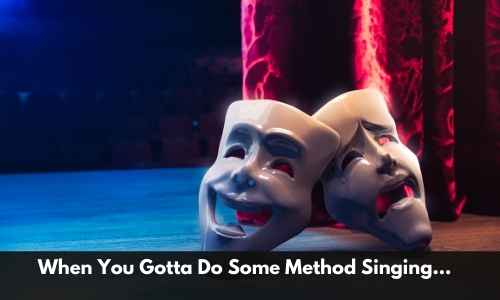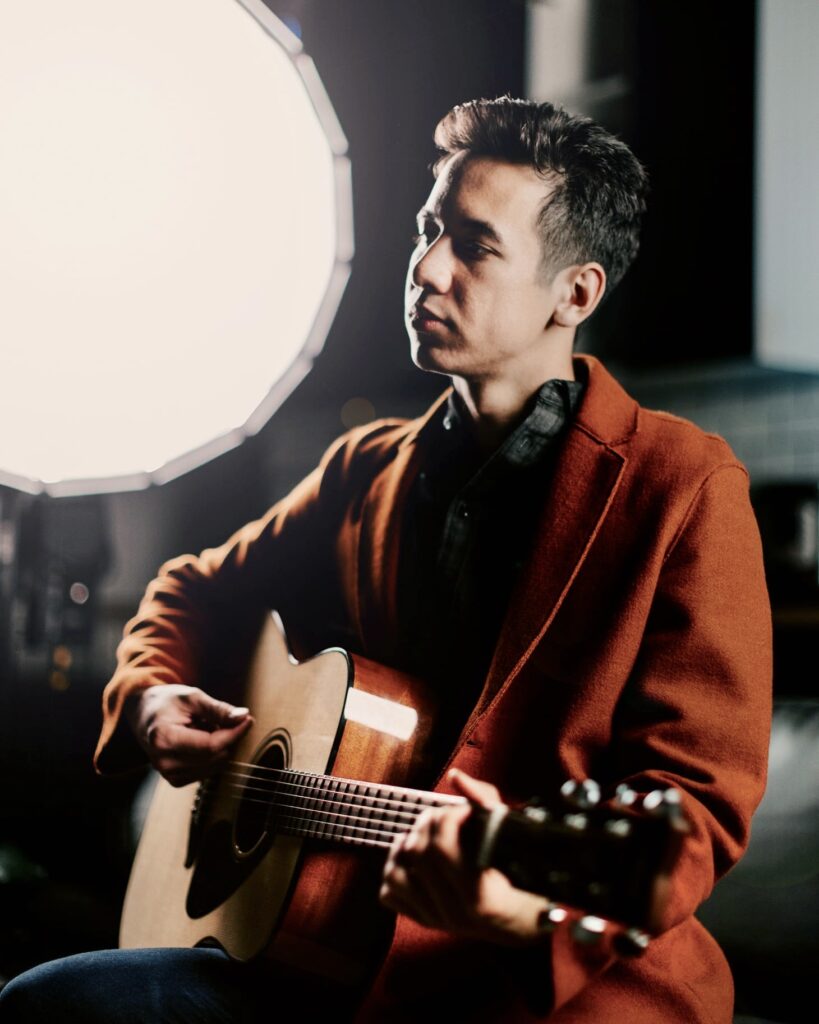Frank Sinatra is one of the greatest singers of our time.
If you want to emulate the legend himself and give yourself that timeless, nostalgic magic that his voice had, there’s a lot you can do!
In order to learn how to sing like Frank Sinatra, we’ll have to look at a few different aspects of his singing and those are:
- His vocal technique…
- His stylistic choices…
- His storytelling…
Singing like Frank Sinatra has a lot to do with good vocal technique, but that’s not all that makes him legendary and original… mainly because plenty of singers have great vocal technique. What makes Frank Sinatra so incredible is how he captivated the world in such a way that it transcends lifetimes…
And that has everything to do with how Frank Sinatra approached singing.
Want to hear the best part?
It’s something you can learn to do yourself!
So let’s get started to captivate the world just like he did.
How To Sing Like Frank Sinatra – His Vocal Technique
The first thing you’re going to want to do if you want to learn how to sing like Frank Sinatra is to learn more about a classical style of singing (as opposed to pop).
Classical singing is a more proper form of singing, where a singer puts a lot of care into the shape of their mouths and their technique in order to sound more mature and polished.
These days, modern pop music has strayed away from classical styles. We are a bit more lax about vocal technique.
Think of classical singing as the type of singing you would hear at a very esteemed event, such as a royal ceremony, a wedding, or in a church mass.
There are several vocal techniques that Frank uses that are more common in a classical style of singing, and you’ll notice that in that fact that he:
- Does not use riffs or runs, and instead sings notes straight
- Has very well-shaped vowels in order to create beautiful, resonant tone
- Sings forward, or “in his mask” (AKA, to avoid having your voice fall back into your throat)
In the very beginning of his career, Frank had voice lessons three times a week in order to learn proper vocal technique…
So don’t be sad if you aren’t seeing the results you want right away.
So there’s your first step: if you haven’t already, train your voice in a classical style of singing. That includes learning to breathe from your diaphragm and shape your mouth with the use of singing vowels. That’s where you’ll get that beautiful resonance that Frank has achieved with his own voice.
1. Singing “in your mask”, or Avoiding Singing in your Throat
In his documentary All or Nothing at All, Frank mentions how vitally important it is that you learn to “sing in your mask” in order to keep your voice out of your throat.
What he means by this is that many singers find themselves with a dull or muddy tone, merely because their resonance or sound is kinda stuck in their throat. So, instead of letting your voice stay low in your throat when you sing, you want to bring it out of the mud, and up closer to your front teeth.
Try it now: imagine singing closer to your teeth, or imagine a point in the front of your face such as your forehead, to focus on as you sing. This awareness should bring your voice right out of your throat, making your tone already rounder, brighter and more resonant.
Or, you can give this video a watch for a demonstration:
2. The Famous Frank-isms

Every singer has their own twist on singing, a little signature thing they do that makes their voice recognizable. That’s called style.
For example, one of Beyoncé’s signature trademarks is her crazy riffs and runs. It’s one thing that makes a Beyoncé song a Beyoncé song.
And there are a few stylistic things he does you can learn to emulate and they are:
- Quick vibrato
- Holding consonants
- Adding dynamics and inflection
We can’t sing like Frank without his Frank-isms!
3. Quick Vibrato
Frank Sinatra’s quick vibrato is one of his staples, and one of the little things that makes his voice so warm and nostalgic. Not only that, it’s one way he strays from a more classical singing style; you’ll often hear very slow vibrato in operatic and very classical music.
Check out this post to help you learn not only what vibrato even is, but to make yours faster, just like Frank’s!
Mastering his vibratos is one of the key steps since he usually stays in one key throughout the entire song.
4. Hold On To Your Consonants!

He does something unique to his consonants that really adds a warmth and maturity to his sound. But remember, Frank knew how to keep things interesting. He did not do this all the way throughout a song, but he did much of the time, and depending on the word.
Most singing is sung on the vowel of a word, because vowels are where your mouth is open and spacious. Consonants close your mouth, so singers keep them very short and quick, and only to enunciate.
However…
Frank does something different with consonants. When he is holding out a longer note, he holds the note on the consonant at the end of the word, rather than the vowel in the middle of the word. That mixed with his quick vibrato equals one of his most recognizable Frank-isms there are!
Check out how he does it here!
At 0:29 in the video, listen carefully to how Frank holds onto the consonant at the end of the words he sings. Notice it clearly in the words I bold in this sentence: “I wanna go and bounce the moon, just like a toy balloon.”
What you hear on the words moon, toy and balloon is that Frank holds out the word on the consonant at the end of the word, so that it sounds more like moonnn, toyyy, and balloonnn. (In singing, ‘y’ is a consonant. Remember how it’s always ‘and sometimes y’ in the English class vowels song?)
So instead of holding out “moon” on the oo vowel, he holds the ’n’. With toy, instead of holding the O vowel, he goes straight to that ‘y’, as well as the ’n’ in balloon. Notice how nice and warm it sounds when he adds that quick vibrato to it as well!
Note the difference at 0:45, when Frank holds the vowel on the word “across”. You can hear that he decides not to hold the ’s’ at the end of the word across; he sings this word on the vowel in the middle.
To be fair, it would sound like a snake was singing if he held out the ’s’, so Frank certainly knew when to use this stylistic choice.
He also holds the vowel at 2:04, when he sings “wonderful fling to be flung,” rather than holding it out on the ‘ng’.
From what I can infer, when he sings a bigger and more climactic note, or if the word ends in a consonant, that’s very hard or awkward-sounding to hold (like ‘s’, ‘k’, ‘t’, etc) he likes to ride that open vowel in the middle of the word.
When he’s singing verses and singing words that have nicer consonant sounds (like ‘n’, ‘m’, ‘ng’, ‘r’ etc), he really likes riding his consonant at the end of the words, but he always switches it up. Watch several of his performances, and you’ll see this crop up all over them.
Try it out yourself!
Choose a song you want to learn how to sing and try both ways; holding onto the vowel and then holding onto the consonant at the end of the word. You’ll probably surprise yourself at how quickly you sound, just like the legend himself!
4. Be One With the Band
There’s something that is especially special about Frank Sinatra, and it’s the way he views being a singer.
Frank Sinatra does not consider himself the singer as the focal point of a song or performance; he considers himself as just another instrument in the ensemble.
You can clearly see this in the way he gives the other musicians in the band—such as the pianist, drummer, guitarist, full orchestra,—space in the song to shine in their own light. Or, you can see it in how he emphasizes a drum hit or a piano chord with a brief gesture or dance move of his own.
Frank Sinatra does not consider them his backing track or something to simply enhance his vocals; he views himself, the singer, as an equal part of the total package.
When you take on this perspective, something special happens.
You allow space in the song. You don’t feel uncomfortable with the parts of the song that you’re not singing; where there are no lyrics.
So often, when singers approach a point in a song such as an instrumental interlude, they suddenly don’t know what to do with themselves. Sometimes singers will just stand still, nodding along, almost awkwardly as they wait for their next lyric.
But Frank doesn’t do this; he embraces the whole band. He knows that every instrument, every part of that band, is essential in giving the song everything it deserves and offers.
There can be an urgency in a song that the vocal doesn’t express as well as the drums do, or a softness in the way the piano plays.
Frank doesn’t hide from spaces between lyrics; he lives for them! You can see it in the way he dances to them, the way he approaches each instrument during their moment to shine and gestures to them so the audience can give them their full attention, too.
When you view singing this way – as just another, equal part of the total package – it will change how you sing, and especially how you feel about those moments when you aren’t singing. This perspective doesn’t mean that the singer doesn’t have a spotlight; it just means that you embrace that the other instruments have spotlights too.
And speaking of spotlights, that leads us to our next Frank-ism.
Confidence.
5. Confidence
You might think that confidence has nothing to do with emulating Frank Sinatra’s voice…
But that’s not true!
Frank Sinatra could easily stand in place of the dictionary’s definition of confidence itself. He walked onto every stage like it was there for him, and he had an ease about singing. He didn’t try to sound good.
Part of that has to do with having a trained voice, but a bigger part of that is how he went out there solely because he wanted to share his gift with the world. If you instead change your attitude toward singing from wanting to sound good, to wanting to just share your love of singing and the song’s message, you’ll already feel and come off more confident.
Not only that, part of the experience we get when we watch Frank Sinatra’s performances is how his confident and relaxed nature makes us feel relaxed. The same way animals can sense fear, we can sense when someone relaxes. And that makes us, the audience, relaxed. If you want to sing like Frankie, then chances are, you want to give people that relaxed and inviting experience that he gave his entire career.
Check out any of his performances, and you’ll see him dancing to the instrumentals, to the drumbeats, and singing “do ba ba’s” to the parts of the music that don’t have lyrics. That is a singer that loves what they do and is merely a conduit to their gift and love of music.
Just check out the pure charisma he has (and I could have linked any of his performances!) https://youtube.com/watch?v=TK0Vdb1RUCk
Here’s a post with even more tips to help you learn to have your own confidence on stage!
Frank Sinatra sang to express an emotion, and to make people feel things. That’s why you have to experiment with your voice with confidence and emotion since it’s emotion that drives people to love your voice and music.
Which leads us to the last and most reputable Frank-ism there is:
Telling us a story.
6. Be a Storyteller

Frank Sinatra was one of the world’s greatest storytellers. He merely told his stories to music.
Anyone can sing a song and sing it well if they have a trained voice, but being a storyteller made Frank stand out.
He made us feel with every word he sang, and it’s because he meant them.
To be a storyteller like Frank Sinatra, some tips are:
- Think about the lyrics you are singing…
- Add dynamics and inflection the same way you would if you were speaking the story…
- Tie your own emotion and experience to the lyrics you sing, whether the song is actually yours…
To sing like Frank Sinatra, tell the song’s story like Frank Sinatra would.
And that starts with actually reading the lyrics of the song!
7. Think About the Lyrics You’re Singing
I’m sure that on over one occasion, you’ve sung a song you’ve sung and known by heart for years… and then one day, you tune into what you’re singing and go, “That’s what the lyrics are?!”
Often, singers get lost in the technical side of singing, the melody, the intricacies of it all. And we overlook things as simple as what the words actually say! And when we don’t pay attention to what we’re saying, how can we possibly tell the story properly?
Find a song you’ve sung for years since you were a kid, and read the lyrics or listen to the song without singing it. Did you notice a lyric you didn’t notice before?
Once you pay attention to what you’re singing, now we have to find out how to sing it in a way that makes people feel that story.
How do we do that?
Easy!
Start with asking yourself how you’d speak it.
8. Dynamics and Inflection – Speak the Story First!
Paying attention to the dynamics and inflections (all those little things) makes a difference.
Take the lyrics of the song you’re singing and sit down with them for a while. Going line by line, and speak the words as if you were telling them to someone in daily conversation.
What are the words saying?
Are they angry? Sad? Hopeful?
What is the situation that’s going on in the song?
Decide how you would speak these words.
Then, sing the song, keeping in mind where you emphasize a word when you speak the lyrics. Perhaps one line is angry, so you add more force or oomph to that word. Or maybe it’s a very sweet line, so you decide to soften your voice.
Tell the story.
And what helps us tell the song’s story even more…
…is to think about an experience or emotion from our own life as we sing it.
Frank sinatra had many experiences to reference and the fastest way is to use your own experiences to create your own meaning for that specific song.
9. Method Singing (A Great Way To Learn How To Sing Like Frank Sinatra)

I call this method singing because it’s the same idea as a concept that’s widely known in acting, which is called method acting.
Method acting is where an actor ties a genuine emotion from an experience they had in their own life to the situation their character is going through, in order to make it feel more real to the audience.
And as singers, we’re actors too!
Especially when we’re singing a cover of someone else’s song.
Frank Sinatra is one of the best examples of a singer who ties their own emotion into everything they sing, for he’s been very vocal about the fact that he sang nothing he didn’t tie his own experience to. If he was singing a sad song, he was imagining some sort of heartbreak or a loss he’d gone through. If he was singing a more joyful song, he was thinking about a joyful experience from his life.
We hang on his every word he sings because he does, too.
He tied all the songs he sang, whether they were his own lyrics, to something or someone from his own life.
As you’re going through your song’s lyrics, whether it’s a cover, take some time to decide what mood this song is. (It may seem strange, but I even have to do this with songs I’ve written myself! After a while, I find myself just singing the words, no longer thinking about the experience that inspired them). So, find an experience that brings out that emotion in you. Use that emotion every time you sing the song.
This will make you an exceptional storyteller, and that you’re feeling the song rather than just singing it will be the difference between your audience hearing you, and believing you.
Here’s another post that goes even more in-depth on adding emotion to help you sharpen your voice and learn how to sing like frank sinatra.
Conclusion
Frank Sinatra had a voice that transcends lifetimes, touches hearts, and shows us just how powerful a voice can be.
Looking from how Frank uses vocal technique, like his quick vibrato or stylistic choice of holding onto the consonants at the end of his words, to his performance attributes and the way he can sing a song he didn’t write and make us feel like he did, gives us many ways to sing just like him.
But through tons of listening and practice repetitions, you can start slowly learning how to sing like frank sinatra and pick off all the nuances that make him unique.
Let me know in the comments what your favorite Frank-isms are, and how well you pulled them off!







